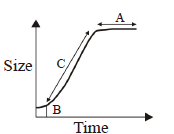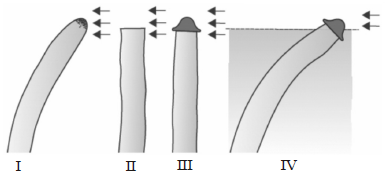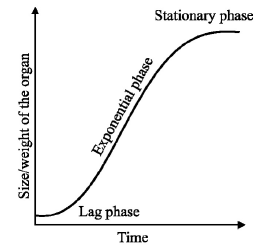Please see Chapter 15 Plant Growth and Development Exam Questions Class 11 Biology below. These important questions with solutions have been prepared based on the latest examination guidelines and syllabus issued by CBSE, NCERT, and KVS. We have provided Class 11 Biology Exam Questions and answers for all chapters in your NCERT Book for Class 11 Biology. These solved problems for The Living World in Class 11 Biology will help you to score more marks in upcoming examinations.
Exam Questions Chapter 15 Plant Growth and Development Class 11 Biology
Objective Questions
Question. Which one includes growth promoters?
(a) Auxin, Cytokinin, ABA
(b) GA, Cytokinin, C2H4
(c) C2H4, ABA
(d) Auxin, Cytokinin, GA
Answer
D
Question. PGRs include
(a) Only growth promoters
(b) Only growth inhibitor
(c) Both growth promoters and growth inhibitor
(d) Only solid hormones, not gaseous hormones
Answer
C
Question. A. Cell division
B. Cell enlargement
C. Pattern formation
D. Tropic growth
E. Flowering
F. Fruiting
G. Seed germination
H. Response to wound
I. Response to stresses of biotic and abiotic origin
Which one is correct?

Answer
C
Question. Statement I – Confirmation of the release of volatile substance from ripened oranges that hastened the ripening of stored unripe bananas
Statement II – Callus formation from the internodal segments of tobacco stem with the Auxin and extracts of vascular tissues / yeast / coconut milk / DNA. Later, Cytokinesis promoting substance was identified, crystallized and named as KINETIN
Statement III – Reporting of appearance of symptoms of bakane / foolish seedling disease caused by fungus. Gibberella fujikuroi, in unifected seedling when they were treated with sterile substance were later identified as GA.
Choose the correct option

Answer
D
Question. The historical experiment on canary grassed coleoptile as a first step in the discovery of auxin was conducted by
(a) Darwin
(b) Went
(c) Kogl
(d) Kurosawa
Answer
A
Question. 3 term – Inhibitor – B, Abscission 11 and Dormin are terms used for the same hormone. That hormone is
(a) Auxin
(b) ABA
(c) C2H4
(d) GA
Answer
B
Question. In arithmetic growth following mitotic cell division, only one daughter cell continues to divide while the other differentiates and matures. The simplest expression of arithmetic growth is exemplified by a root elongating at a constant rate. On plotting the length of the organ against time, a linear curve is obtained, as seen in the graph. Mathematically, it is expressed as

(a) L1 = L0 + rt (L1 + Length at time “t” , L0 = length at a time ‘zero’, rt = growth rate/ elongation per unit time)
(b) L1 = L0ert
(c) L1 = L0 + rt or L1 = L0ert
(d) L1 = 2 x L0
Answer
A
Question. Plant growth substance generally
(a) Have a single role
(b) Are species-specific
(c) Are produced in many parts of plant
(d) Affects mainly the cells that produce them
Answer C
C
Question. The hormone responsible for phototropism is
(a) Auxin
(b) C2H4
(c) ABA
(d) GA
Answer
A
Question. If a shoot cutting is treated with auxin, which of the following is likely to result?
(a) Extensive root production
(b) Suppression of apical dominance
(c) Growth of lateral buds
(d) Bolting of to shoot
Answer
A
Question. Which of the following synthetic phytohormone was discovered as a breakdown product of DNA?
(a) Kinetin
(b) 2, 4-D
(c) NAA
(d) Thidiazuron
Answer
A
Question. Gaseous hormone is
(a) ethylene
(b) ethane
(c) acetylene
(d) benzaldehyde
Answer
A
Question. Which of the following hormone is concerned with climacteric respiration?
(a) Ethylene
(b) Auxin
(c) GA1
(d) Cytokinin
Answer
A
Question. Lead abscission, fruit fall, bud dormancy occurs by which of the following phytohormone?
(a) Auxin
(b) Cytokinins
(c) Gibberellins
(d) Abscisic acid
Answer
D
Question. ABA is antagonistic to
(a) GA
(b) cytokinin
(c) ethylene
(d) auxin
Answer
A
Question. Photoperiodism is
(a) recurrence of day and night.
(b) effect of day length on flowering of a plant.
(c) flowering plant.
(d) growth curvature in response to light.
Answer
B
Question. Plants requiring exposure to light for less than critical period in order to flower are called ________.
(a) long day plants.
(b) day neutral plants.
(c) intermediate day plants.
(d) short day plants.
Answer
D
Question. Effect of low temperature which shortens vegetative period and hastens flowering is called _______.
(a) photoperiodism
(b) transpiration
(c) vernalization
(d) photolysis
Answer
C
Question. 6-furfuryl amino purine, 2, 4-dichlorophenoxy acetic acid and indole-3 acetic acid are examples respectively for
(a) synthetic auxin, kinetin and natural auxin.
(b) gibberellin, natural auxin and kinetin.
(c) natural auxin, kinetin and synthetic auxin.
(d) kinetin, synthetic auxin and natural auxin.
Answer
D
Statement Type Question
Question. Which of the following statement regarding vernalisation is correct?
(a) Vernalisation refers to the promotion of flowering by a period of low temperature.
(b) The spring variety of crops are normally planted in the spring and come to flower before the end of the growing season.
(c) It is not seen in biennial plants.
(d) Subjecting cold treatment to sugar beet will result in flowering.
Answer
C
Question. Which of the following statements on phytohormones & their action are correct?
(i) Cytokinins specially help in delaying senescence.
(ii) Auxins are involved in regulating apical dominance.
(iii) Ethylene is specially useful in enhancing seed germination.
(iv) Gibberellins are responsible for immature falling of leaves.
(a) (i) and (iii) only
(b) (i) and (iv) only
(c) (i) and (ii) only
(d) (ii) and (iii) only
Answer
C
Question. Refer the following statements.
(i) Promotes flowering in pineapple.
(ii) Used to prepare weed free lawn.
(iii) Promotes the abscission of older mature leaves and fruits.
The above functions are carried out by
(a) GA
(b) C2H4
(c) ABA
(d) Auxin
Answer
D
Matching Type Questions
Question. Match the growth regulators given in column I with their action given in column II and choose the correct combination from the options given below.
| Column-I (Growth Regulator) | Column-II (Action) |
| A. Abscisic acid | I. Delays leaf senescence |
| B. Ethylene | II. Inhibits seed germination |
| C. Cytokinin | III. Herbicide |
| D. Auxin | IV. Hastens fruit ripening |
(a) A-II; B-IV; C-I; D-III.
(b) A-I; B-II; C-III; D-IV
(c) A-II; B-III; C-IV; D-I.
(d) A-II; B-I; C-III; D-IV
Answer
A
Question. Match the growth regulators given in column-I with the processes given in column-II and choose the correct combination.
| Column-I (Growth regulators) | Column-II (Processes) |
| A Auxin | I. Colouring test in lemon |
| B Gibberellin | II. Cell division test in plants |
| C Cytokinin | III. Avena curvature test |
| D Ethylene | IV. Dwarf corn test |
(a) A – III; B – IV; C – II; D – I
(b) A – I; B – IV; C – II; D – III
(c) A – IV; B – III; C – I; D – II
(d) A – II; B – I; C – IV; D – III
Answer
A
Question. Refer the functions of the growth hormones given below.
I. Cell division
II. Cell enlargement
III. Pattern formation
IV. Tropic growth
V Flowering
VI. Fruiting
VII. Seed germination
VIII. Response to wound
IX. Response to stresses of biotic and abiotic origin
Identify the functions of growth promoters and growth inhibitors from the above.
| Functions of growth promoters | Functions of growth inhibitor |
| (a) I, II, VII, IX | III, IV, V, VI, VII |
| (b) VIII, IX | I, II, III, IV, V, VI, VII |
| (c) I, II, III, IV, V, VI, VII | VIII, IX |
| (d) I, II, III, IV, V, VI, VII, IX | VIII |
Answer
C
Question. Which one of the following pairs is incorrectly matched?
(a) Adenine derivative – Kinetin
(b) Carotenoid derivative – ABA
(c) Terpenes – IAA
(d) Indole compounds – IBA
Answer
C
Diagram Type Questions
Question. The picture given below shows a graph drawn on the parameters of growth versus time. Identify A, B, C marked in the given graph.

| A | B | C |
| (a) Exponential phase | Log phase | Stationary phase |
| (b) Stationary phase | Lag phase | Log phase |
| (c) Log phase | Stationary phase | Logarithmic phase |
| (d) Log phase | Lag phase | Stationary phase |
Answer
B
Question. The following diagram shows four coleoptiles set up (I,II, III & IV) at the start of an experiment.

Fig : Experiment used to demonstrate that tip of the coleoptile is the source of auxin. Arrows indicate direction of light
Which two coleoptiles will both bend towards the light source?
(a) I and II
(b) I and IV
(c) II and III
(d) III and IV
Answer
D
Question. The graph given below shows a geometrical growth rate.

Which of the following statement regarding the above graph is incorrect?
(a) The initial growth is slow, thereafter exponential phase and then stationary phase.
(b) A sigmoidal curve is a characteristic of living organism growing in a natural environment.
(c) With limited nutrient supply, the growth rate increases rapidly leading to a exponential phase.
(d) Geometrical growth is typical for all cells, tissues and organs of a plant.
Answer
C
Question. Maryland Mammoth Tobacco is a short day plant. Its critical duration of darkness is 10 hours. Under which of the following conditions will Maryland Mammoth tobacco not flower ?

Answer
A
Critical Thinking Type Questions
Question. Maximal size in terms of wall thickening and protoplasmic modification are achieved by
(a) cells of divisional phase.
(b) cells of maturation phase.
(c) cells of elongation phase.
(d) cells of meristematic tissue.
Answer
B
Question. A sigmoidal curve is obtained in geometrical growth because
(a) it has lag, log and then stationary phase.
(b) one daughter cell remains meristematic while the other daughter cell differentiates and matures.
(c) of the effect of environment on mitosis.
(d) none of the above
Answer
A
Question. The exponential growth can be expressed as W1 = W0 ert .
What is ‘r’ in the expression ?
(a) Relative growth rate and depends on final size.
(b) Absolute growth rate & depends on initial size.
(c) Relative growth and also referred to as efficiency index.
(d) None of the above
Answer
C
Question. De-differentiation is
(a) regaining the lost capacity of division by living cells.
(b) the ability of plant to produce different structures in response to environment.
(c) the intrinsic factor affecting plant growth.
(d) none of the above.
Answer
A
Question. A phytohormone is
(a) an ion that alters turgor pressure.
(b) small molecules of diverse chemical composition.
(c) a pigment responds to environmental changes.
(d) a secondary metabolic compound.
Answer
B
Question. Ethylene is used for
(a) retarding ripening of tomatoes.
(b) ripening of fruits.
(c) slowing down ripening of apples.
(d) both (b) and (c).
Answer
B